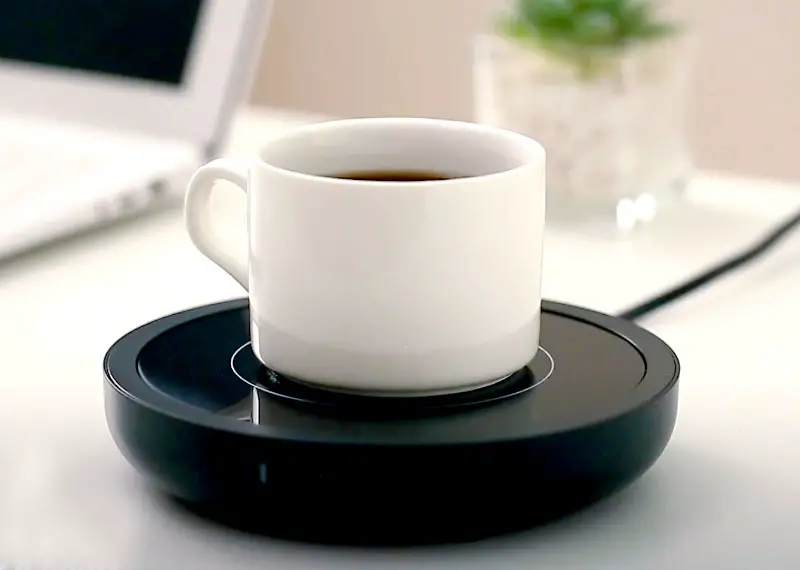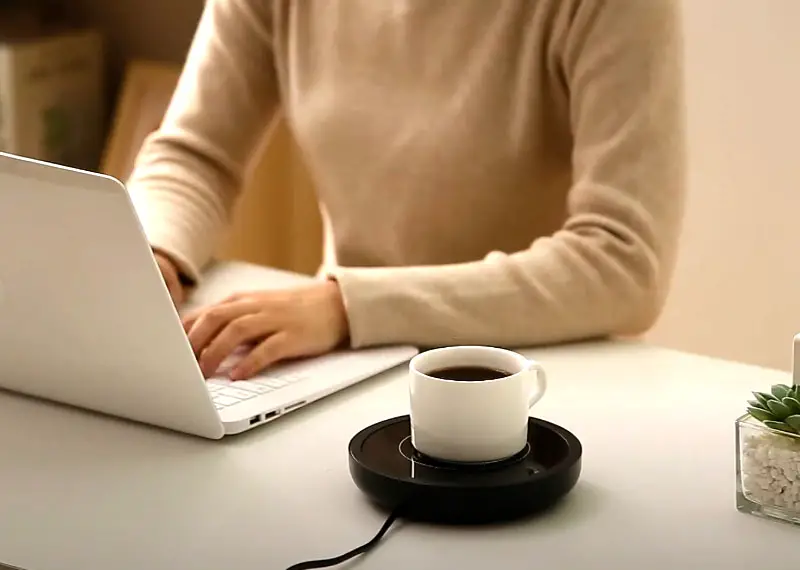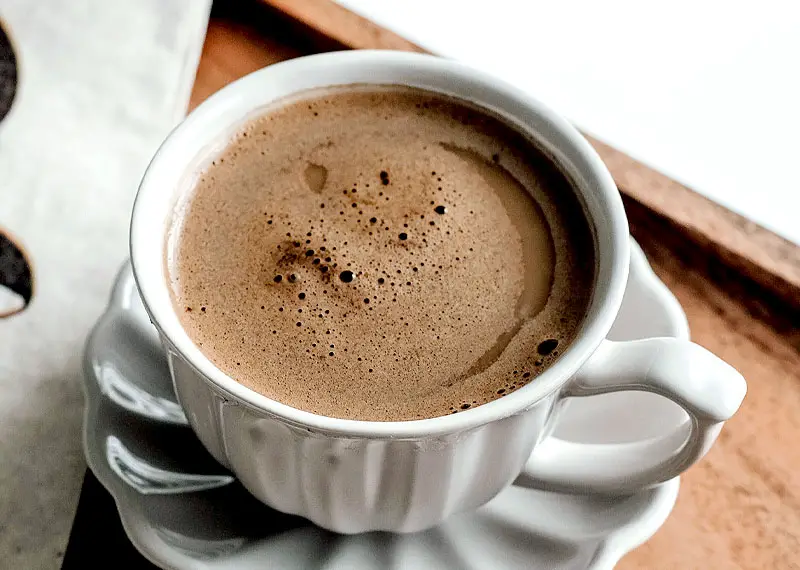As an Amazon Associate, I earn from qualifying purchases at no extra cost to you.
How to Reheat Coffee: Expert Tips for Enjoying the Perfect Brew
Coffee lovers often find themselves in a situation where their cup of coffee has gone cold, leaving them with the desire to warm it up and savor its flavors once again. Whether you forgot about it or were interrupted mid-sip, reheating coffee can revive its warmth and taste.
To reheat coffee, pour it into a microwave-safe container and heat in short intervals until it reaches the desired temperature. Reheating coffee can be done easily in a microwave by following a few simple steps.
While reheating may not recreate the freshness of a freshly brewed cup, it can still provide a satisfying experience. We will discuss different methods to effectively reheat coffee and offer some tips to ensure the best results. So, if you want to enjoy a warm cup of coffee without having to brew a new one, keep reading.

Methods for Reheating Coffee
There’s nothing worse than taking that first sip of cold coffee. But fear not, because reheating your coffee is a quick and easy way to bring it back to life. In this article, we’ll explore three different methods for reheating your coffee: using a microwave, using a stovetop, and using an electric kettle.
Using a Microwave
When it comes to reheating your coffee, the microwave is probably the most convenient option. Here’s a step-by-step guide:
- Pour your leftover coffee into a microwave-safe mug.
- Place a microwave-safe cover or microwave-safe plate on top of the mug to prevent any splatters.
- Heat the coffee in the microwave for about 30 seconds at a time. Be sure to use the appropriate power level to prevent overheating.
- After each 30-second interval, give the coffee a stir to ensure even heating.
- Continue this process until the coffee reaches your desired temperature.
Using a Stovetop
If you don’t mind taking a few extra minutes, reheating your coffee on a stovetop can result in a more evenly heated cup. Follow these steps:
- Pour your coffee into a small saucepan.
- Place the saucepan on the stovetop over low to medium heat.
- Using a whisk or spoon, stir the coffee continuously to prevent it from scorching or forming skin.
- Continue stirring until the coffee reaches your desired temperature.
- Once heated, pour the coffee back into your mug and enjoy.
Using an Electric Kettle
If you’re looking for a speedy solution, an electric kettle can come in handy for reheating your coffee. Here’s how to do it:
- Pour your coffee into a heat-resistant container that fits in your electric kettle.
- Fill the electric kettle with water, ensuring that it covers the bottom of the container.
- Place the container with the coffee into the kettle, making sure it is stable.
- Turn on the electric kettle and let the water heat up. The steam from the boiling water will gently heat the coffee.
- Once the water reaches a boil, carefully remove the container from the kettle and pour the reheated coffee into your mug.
Now that you know these three methods for reheating your coffee, you’ll never have to suffer through a cold cup again. Whether you use a microwave, stovetop, or electric kettle, you can enjoy a piping hot cup of coffee whenever you need it.

Best Practices for Reheating Coffee
Reheating coffee is a common practice, but it’s important to do it right to maintain the best flavor and quality. Here are some best practices for reheating coffee:
Choosing the right container
When it comes to reheating coffee, the container you choose can make a significant difference in the taste and quality of your brew. It is recommended to use a heat-resistant container made of glass or ceramic.
These materials help distribute heat evenly and prevent any unwanted flavors or chemicals from leaching into your coffee. Avoid using plastic containers or Styrofoam cups as they can release toxins when exposed to high temperatures.
Adding water to prevent bitterness
Reheating coffee can sometimes result in a bitter taste due to the breakdown of certain compounds and oils. To avoid this, it is a good idea to add a small amount of water to your reheating process.
This helps dilute any strong flavors and prevents your coffee from becoming overly bitter. Simply adding a tablespoon or two of water to your cup before reheating can greatly improve the overall taste and balance of your coffee.
Stirring and monitoring the temperature
To ensure that your reheated coffee is enjoyable, it is important to stir it well after reheating. This helps redistribute any settled flavors and ensures a consistent taste throughout the entire cup.
Additionally, monitoring the temperature of your reheated coffee is crucial. Overheating your coffee can lead to a burnt taste, while not heating it enough can result in a lukewarm beverage. Use a food thermometer or simply gauge the temperature by touch to achieve the desired warmth for your coffee.
Tips for Enhancing the Reheated Brew
Reheating coffee may not be ideal for perfectionists, but sometimes a busy schedule or unforeseen interruptions leave us no choice. While reheated coffee may not have the exact same quality as freshly brewed coffee, there are some tips you can follow to make the most out of your reheated brew.

By adding flavored syrups or spices, using alternative milk or creamer options, and experimenting with different brewing ratios, you can elevate your reheated coffee experience.
Adding Flavored Syrups Or Spices
If you prefer a little sweetness or extra flavor in your coffee, adding flavored syrups or spices is an excellent way to enhance your reheated brew. Here are some options to consider:
- Flavored syrups: Whether you enjoy classics like vanilla or caramel, or prefer more unique flavors like hazelnut or pumpkin spice, the right syrup can transform your coffee into a delightful treat.
- Spices: Experiment with adding a pinch of cinnamon, nutmeg, or cardamom to your reheated coffee for an aromatic and flavorful twist. These spices not only add depth but also complement the natural flavors of coffee.
Using Alternative Milk Or Creamer Options
If you’re looking to make your reheated coffee creamier or have dietary restrictions, alternative milk or creamer options can be a game-changer. Consider these alternatives:
- Plant-based milk: Whether it’s almond, soy, oat, or coconut milk, these dairy-free options can add a touch of creaminess to your reheated brew. Choose the one that suits your taste preferences.
- Non-dairy creamers: Non-dairy creamers, such as those made from soy or coconut, can mimic the texture and taste of traditional cream. They come in various flavors, allowing you to customize your coffee experience.
Experimenting with Different Brewing Ratios
When it comes to reheating coffee, adjusting the brewing ratio can make a difference in taste and strength. Try these suggestions to find your ideal brew:
- Decrease the water: Reheating a smaller amount of coffee with less water can intensify the flavor and aroma.
- Keep the ratio consistent: If you prefer a specific coffee-to-water ratio, stick to it when reheating. Maintaining consistency can help preserve the original taste profile.
- Adjust the coffee amount: Increasing or decreasing the amount of coffee grounds based on your preference can result in a bolder or milder flavor respectively.
Remember, while these tips can enhance the reheated brew, freshly brewed coffee will always offer the best taste. However, when time is short and reheating is necessary, adding flavored syrups or spices, using alternative milk or creamer options, and experimenting with different brewing ratios can make your reheated coffee more enjoyable.
Cautions and Things to Consider
While reheating your leftover coffee can be a convenient way to enjoy a hot cuppa again, there are a few key cautions and considerations to keep in mind. By being mindful of these factors, you can ensure that your reheated coffee tastes its best and retains its quality.
In this section, we will discuss the importance of avoiding reheating coffee multiple times, being mindful of coffee quality, and considering alternative ways to use leftover coffee.
Avoiding Reheating Coffee Multiple Times
Repeatedly reheating your coffee is something you should avoid. Every time you heat up coffee, some of its taste and aroma can be lost, leaving you with a subpar drinking experience.
Additionally, reheating coffee multiple times can contribute to the breakdown of the coffee’s compounds, resulting in a bitter and harsh flavor.
To preserve the integrity of your coffee, it is best to only reheat it once. If you find that you have more coffee than you can consume in one sitting, consider reheating only the amount you plan to drink and saving the remainder for later.
Being Mindful Of Coffee Quality
The quality of your coffee plays a crucial role in how it will taste when reheated. If you start with a low-quality coffee, reheating it may not improve the flavor. It can amplify any negative characteristics, such as a stale or burnt taste.
To ensure a better-tasting reheated coffee, choose a high-quality coffee with a flavor profile that you enjoy. Specialty coffee beans, freshly ground right before brewing, can often result in a better-tasting cup, even when reheated. Invest in well-sourced beans from trusted brands or local roasters for a more satisfying coffee experience.
Considering Alternative Ways To Use Leftover Coffee
Instead of simply reheating your leftover coffee, you might also consider exploring alternative ways to put it to use. Leftover coffee can be a versatile ingredient in cooking and baking, adding depth and complexity to various recipes.
Here are a few ideas to make use of your leftover coffee:
- Create coffee ice cubes for refreshing iced coffee drinks;
- Use it to make a flavorful coffee glaze for cakes or pastries;
- Blend it into your favorite smoothie or milkshake for a coffee-infused treat;
- Add a splash to your favorite chocolate desserts for an added richness.
By considering these alternative uses, you can make the most of your leftover coffee and add a delightful twist to your culinary endeavors.
Expert Opinions on Reheating Coffee
When it comes to reheating coffee, there are varied opinions from experts in the coffee industry. Professional baristas and coffee connoisseurs offer insights on how to effectively reheat your coffee without compromising its taste. Let’s delve into these expert opinions and discover the best techniques to make your reheated coffee just as enjoyable as a fresh brew.
Views from Professional Baristas
Professional baristas, with their deep knowledge of coffee brewing and flavors, have shared their expert opinions on reheating coffee. Here are some key insights from the coffee experts:
- Heat Gradually: When reheating your coffee, it’s crucial to heat it gradually instead of using high heat right from the start. Professional baristas suggest using a low heat setting to slowly warm up your coffee. This prevents scorching and helps retain the delicate flavors.
- Use a French Press: If you have a French press at hand, it can be a useful tool for reheating coffee. Professional baristas recommend pouring your cold coffee into the French press, priming it by pressing the plunger down slightly, and then pouring the hot water over it. This method revitalizes the coffee without losing its essence.
- Consider Brewing Fresh Coffee: While reheating coffee is an option, some baristas propose brewing a fresh cup instead. This ensures the highest quality and optimal flavor experience. It may be more time-consuming, but it guarantees a satisfying coffee break.
Insights from Coffee Connoisseurs
Coffee connoisseurs, known for their refined taste and appreciation of the complexities in coffee, also offer their thoughts on reheating coffee. Here’s what they suggest:
- Invest in a Coffee Warming Plate: Coffee connoisseurs recommend using a coffee warming plate to keep your coffee warm for longer periods without compromising taste. These plates provide a gentle and consistent heat, maintaining the flavors and aromas of your coffee.
- Store Coffee in a Vacuum-Sealed Container: To preserve the freshness of your coffee and enhance its flavor longevity, coffee connoisseurs advise storing your coffee in a vacuum-sealed container. This helps prevent flavor loss and ensures a better taste when reheating.
- Experiment with Different Reheating Methods: Coffee enthusiasts suggest experimenting with various reheating methods to find one that suits you best. Whether it’s the stovetop, microwave, or other techniques, test different approaches and observe the impact on flavor and aroma. This exploration can lead you to your preferred reheating technique.
By considering the perspectives of both professional baristas and coffee connoisseurs, you can gather valuable insights on reheating coffee. Whether you choose to heat gradually, use a French press, try a coffee warming plate, or opt for brewing fresh coffee, these expert opinions can guide you towards the most satisfying cup of reheated coffee.
Reheating Coffee Versus Making a Fresh Brew
Whether you’re a coffee enthusiast or just looking for a quick caffeine fix, the eternal debate of reheating coffee versus making a fresh brew is one that we’ve all faced at some point.
There are moments when time is of the essence and reheating seems like the easiest option, but does it compromise the quality of your beloved cup of Joe?
In this section, we’ll explore the pros and cons of reheating coffee and help you decide when to opt for reheating versus making a fresh cup.
Pros and Cons of Reheating Coffee
Reheating coffee offers a convenient solution for those times when you can’t spare a moment for brewing a fresh pot. However, it’s important to weigh the pros and cons before relying on reheating as your go-to coffee fix. Here are the main points to consider:
| Pros | Cons |
|---|---|
|
|
While reheating is a convenient option, it’s important to note that the quality of the reheated coffee may not match that of a freshly brewed cup. The flavors and aromas tend to degrade over time, leading to a less enjoyable experience. However, if time is of the essence and you can overlook the potential loss in quality, reheating can still provide a satisfying caffeine boost.
When to Opt for Reheating Versus Making a Fresh Cup
Knowing when to opt for reheating versus making a fresh cup of coffee can be a game-changer. Here are a few scenarios where reheating might be the better choice:
- You’re in a rush and can’t spare the time to brew a fresh pot.
- You have leftover coffee from earlier and want to reduce waste.
- You’re not overly concerned about taste and are simply looking for a quick caffeine fix.
On the other hand, you should consider making a fresh brew in the following circumstances:
- You prioritize taste and aroma and are willing to invest a little extra time.
- Your coffee has been sitting out for an extended period and has lost its freshness.
- You have access to high-quality beans and want to savor the full coffee experience.
Ultimately, the choice between reheating coffee and making a fresh brew depends on your personal priorities and circumstances.
While reheating may offer convenience when time is limited, it’s important to remember that a fresh cup of coffee provides a superior taste and aroma.
So, weigh the pros and cons, consider your preferences, and make the choice that will satisfy your coffee cravings in the best way possible!
Final Words
Reheating coffee is a common practice, but it’s important to do it right to preserve the flavor and quality. By following the tips mentioned in this blog post, you can ensure a delicious cup of reheated coffee every time.
Remember to use a microwave or stovetop method, avoid boiling the coffee, and store any leftover coffee properly. Whether you enjoy a quick caffeine fix or savor the taste, reheating coffee can be a convenient solution. Happy sipping!
